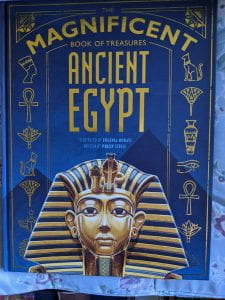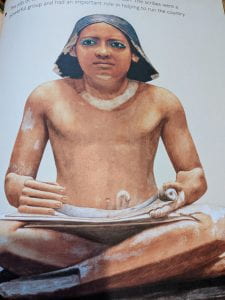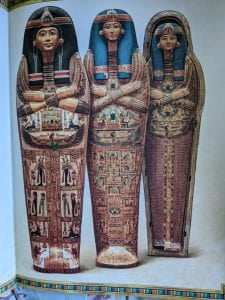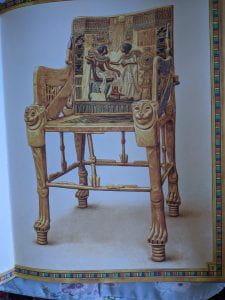
Bloomsbury Education, 9781801995047
As I have often said before when blogging, I have been an avid lover of all things Egyptian since I was a small child. That passion has not abated over the years and I am delighted to say that the subject is also loved by millions of others, including small children. Part of this is due to the inclusion of the subject in to the National Curriculum and hence there are a considerable number of information books published each year. However in order to really get a feel for the subject it is important that good fiction stories are available. Over the past few years we have seen quite a few such books, often to connect with the centenary of finding Tutankhamun’s tomb, but Terry Deary was writing about the subject 20 years ago.
This book is actually a compilation of four stories that were originally published in 2004. They include stories about building the pyramids, stealing from Tutankhamun’s tomb, embalming mummies and finding buried treasure. All of the stories are exciting and have a real sense that the author has done his research about the Egyptian culture. At the end of each story there is a section which invites the reader to think about what they have read and to perhaps ask some questions. There are also facts about real life characters, which helps to round out the stories. The stories are aimed at the newly confident reader and the short length of each story also makes them very suitable for reading in class. I particularly enjoy the fact that the stories are all so different, so we get a feel for different periods of history, together with jobs, status and the continuity of life within Ancient Egypt.
Although these stories are now 20 years old, they have stood the test of time and are just as exciting and enjoyable today as they were when first written. This is definitely a book that will be a great hit for the top of KS1 and those at the beginning of KS2; not only can children just enjoy the story, but it can also serve as a springboard into learning about the subject in more detail.
The author Terry Deary
Terry Deary is the author of over 300 fiction and non-fiction books, which have been published in 40 languages. His Horrible Histories series celebrated its 30th anniversary in 2023, having sold over 30 million copies worldwide and been adapted as a movie, a television series, theatre tours and museum exhibitions. Terry’s non-fiction has been consistently on the bestseller lists since 1994, and he was voted ‘Outstanding children’s non-fiction author of the 20th Century’ by Books for Keeps magazine.
and been adapted as a movie, a television series, theatre tours and museum exhibitions. Terry’s non-fiction has been consistently on the bestseller lists since 1994, and he was voted ‘Outstanding children’s non-fiction author of the 20th Century’ by Books for Keeps magazine.

 November and secondly to commemorate the centenary of the discovery of Tutankhamun’s tomb by Howard Carter and Lord Caernarvon. Of course I was absolutely delighted to do so, mainly because I love Ancient Egypt and as a child in the 1960s I had ambitions to be an Egyptologist. This year also sees the bicentenary of Champollion’s first work which opened a window on how we understand hieroglyphs, so all told this is a very important year for understanding and celebrating the wonder that is Egypt. This led to an explosion in interest from museums and collectors in Europe and then the USA What this really shows is how items have been transported across the world in the last two hundred years, finding homes from the USA to Europe, but also thankfully being cared for in Egypt itself. The new Grand Egyptian Museum in Cairo is scheduled to open in November 2022, to coincide with the centenary commemoration. It will be the largest archaeological museum in the world and I would love to go back to Egypt and visit it.
November and secondly to commemorate the centenary of the discovery of Tutankhamun’s tomb by Howard Carter and Lord Caernarvon. Of course I was absolutely delighted to do so, mainly because I love Ancient Egypt and as a child in the 1960s I had ambitions to be an Egyptologist. This year also sees the bicentenary of Champollion’s first work which opened a window on how we understand hieroglyphs, so all told this is a very important year for understanding and celebrating the wonder that is Egypt. This led to an explosion in interest from museums and collectors in Europe and then the USA What this really shows is how items have been transported across the world in the last two hundred years, finding homes from the USA to Europe, but also thankfully being cared for in Egypt itself. The new Grand Egyptian Museum in Cairo is scheduled to open in November 2022, to coincide with the centenary commemoration. It will be the largest archaeological museum in the world and I would love to go back to Egypt and visit it. many of the images date from that dynasty and the following one, there are also beautiful artifacts from 800 years earlier and also much later. One of the objects that I am particularly fond of is a small statue of a seated scribe, which although it is nearly 4500 years old is stunningly modeled and gives a feeling of great calm and character. It seems strange that whilst Egyptian wall carvings and paintings appear very flat, the sculptures are far more lifelike, even at this early stage of the civilization.
many of the images date from that dynasty and the following one, there are also beautiful artifacts from 800 years earlier and also much later. One of the objects that I am particularly fond of is a small statue of a seated scribe, which although it is nearly 4500 years old is stunningly modeled and gives a feeling of great calm and character. It seems strange that whilst Egyptian wall carvings and paintings appear very flat, the sculptures are far more lifelike, even at this early stage of the civilization. Another set of images that are really stunning are the set of three inter-stacking coffins for a princess Henettawy. She lived about 400 years after Tutankhamun and as a member of the royal family she served as an important priestess of Amun-Ra. In order to find out more about this lady, I visited the website of the Metropolitan Museum of Art at
Another set of images that are really stunning are the set of three inter-stacking coffins for a princess Henettawy. She lived about 400 years after Tutankhamun and as a member of the royal family she served as an important priestess of Amun-Ra. In order to find out more about this lady, I visited the website of the Metropolitan Museum of Art at  am happy to say that I have actually seen it when we visited Egypt in the early 1990s. The throne of Tutankhamun is absolutely exquisite from all angles; however, it is the back rest that really draws everyone’s’ attention. The image of the young pharaoh and his wife is so beautifully portrayed, with a real sense of the close relationship that they appeared to have. Whilst this type of imagery became quite normal during the reign of his father Akhenaten, it is far less formal than is usually found in most Egyptian art work and definitely when portraying royalty.
am happy to say that I have actually seen it when we visited Egypt in the early 1990s. The throne of Tutankhamun is absolutely exquisite from all angles; however, it is the back rest that really draws everyone’s’ attention. The image of the young pharaoh and his wife is so beautifully portrayed, with a real sense of the close relationship that they appeared to have. Whilst this type of imagery became quite normal during the reign of his father Akhenaten, it is far less formal than is usually found in most Egyptian art work and definitely when portraying royalty.